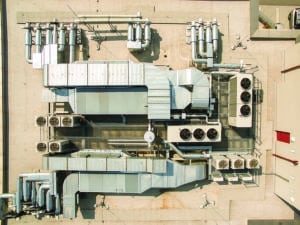
Owners of Boston’s largest buildings have until 2050 to comply with new city regulations that would require them to meet net zero carbon emissions goals. Handel Architects designed MP Boston’s Winthrop Center skyscraper to use 65 percent less energy than a traditional office tower. Photo by Steve Adams | Banker & Tradesman Staff
Walk around Boston these days, and the never-ending building boom is certainly alive and well. Construction cranes are as much of a mainstay on the skyline as the Prudential Tower and the former Hancock Tower now known as 200 Clarendon St.
As the clock ticks towards 2050, construction workers could be equally busy inside existing towers to retrofit them for a new, net zero future.
“Some skeptics may have said, ‘Well, it’s going to scare off development because these are seen as onerous, or these are going to be too costly and too expensive for retrofits or for building green,” said Matt O’Malley, chief sustainability officer at Vicinity Energy and former Boston City Council president. “It’s even more reinforced the fact that, when you build something that’s sustainable, when you build something that helps us meet this moment, you are almost always going to save money.”
Boston passed the second phase of its Building Energy Reporting and Disclosure Ordinance, or BERDO, last fall. The measure builds upon the original 2013 version that required buildings 35,000 square feet or larger or that have at least 35 units of housing to report energy and water usage to the city. BERDO 2.0, O’Malley’s creation, reduced the threshold to 20,000 square feet and 15 housing units and added a stipulation that large buildings move to net-zero carbon emissions by 2050.
“There is no doubt that the next 10 years of real estate development, whether new construction or existing buildings, will be impacted by current and pending climate legislation, regulations and building codes – all of which have degrees of net zero construction commitments by varying dates,” said Yve Torrie, director of climate, energy & resilience for A Better City. “Even though net zero construction in new buildings is further along in the design and development process than existing buildings, all the wrinkles have not yet been ironed out.”
Vicinity Energy is trying to provide a solution to at least one of those wrinkles in the form of electrically-generated “eSteam,” distributed through its existing Boston and Cambridge district steam systems for heating, cooling and sterilizing lab equipment. But other challenges remain.
“Technological solutions aren’t available for all building typologies, the workforce to operate these increasingly smart buildings isn’t available and the greening of the grid and [efforts to] increase in its capacity to meet electrification demands remain on a 2050 timeline,” Torrie said.
Wait-and-Retrofit Strategy for Some Buildings
Given the size thresholds stipulated by BERDO 2.0, there isn’t going to be a rush to retrofit most of the city’s structures. The measure only applies to about 4 percent of Boston’s buildings, but this cluster of large buildings accounts for more than half the carbon emissions in the city.
BERDO 2.0 allows the owners of these buildings to wait and replace things like heating and cooling systems at the end of their natural life cycles. Other changes on the docket include better insulating buildings, using cleaner energy sources and turning off mechanical systems when they aren’t needed to be in use. Some of those practices can take place earlier.
“Right now, the focus is making sure that each building owner goes through third-party verification to estimate their energy use and make sure that’s being reported. Then there’s a timeline after that, based off how large your building is,” said Jess Morris, assistant vice president of public affairs at Benchmark Strategies and who worked on crafting BERDO 2.0 while working for six years as chief of staff for O’Malley. “There’s a timeline on getting to those binding targets, and it’s all based off different building types as well. There’ll be different expectations based off that type.”

Boston’s BERDO 2.0 rules allow the owners of large buildings to wait and replace things like heating and cooling systems at the end of their natural life cycles.
Some Tenants Seek Out Low-Carbon Space
But BERDO isn’t the only factor pushing sustainability and a drive to go net-zero by 2050. Numerous corporations have their own initiatives to embark on significantly more sustainable practices. More than 3,000 companies are part of the Net-Zero Standard that has the same 2050 timeline as BERDO 2.0.
Energy use in an office building is a major factor in achieving that goal. In turn, that can spur more development, as companies want to be in newer, more efficient buildings to achieve their own sustainability goals.
“Differentiating between corporate governance and commercial real estate, [landlords] have their tenants now telling them, ‘I need to know what my carbon footprint impact is for my office space that I’m renting from you,’” said Jack Griffin, vice president of facilities and building solutions at Veolia North America. “All of those tenants want to know what the impacts are, so that definitely drives a value perspective between a class A and a class C and even a class B office space.”
Initiatives like BERDO 2.0 will certainly influence the future of construction and buildouts in Boston, but its boosters don’t view it as an impediment to growth.
“Even in the lean times in the Great Recession and after, things were leaner, but we were still doing much better compared to other cities and similar-sized cities,” O’Malley said. “There’s a reason why companies want to come to Boston, and there’s a reason why businesses want to stay in Boston.”






